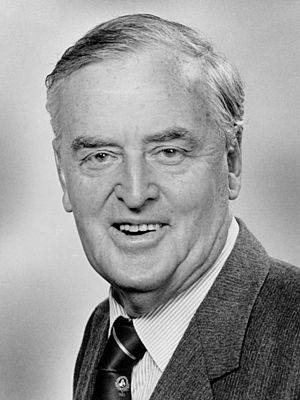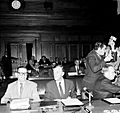Joh Bjelke-Petersen facts for kids
Quick facts for kids
Sir Joh Bjelke-Petersen
|
|||||||||||||||||||||||||||
|---|---|---|---|---|---|---|---|---|---|---|---|---|---|---|---|---|---|---|---|---|---|---|---|---|---|---|---|
 |
|||||||||||||||||||||||||||
| 31st Premier of Queensland Elections: 1969, 1972, 1974, 1977, 1980, 1983, 1986 |
|||||||||||||||||||||||||||
| In office 8 August 1968 – 1 December 1987 |
|||||||||||||||||||||||||||
| Monarch | Elizabeth II | ||||||||||||||||||||||||||
| Governor | Alan Mansfield Colin Hannah James Ramsay Walter Campbell |
||||||||||||||||||||||||||
| Deputy | Gordon Chalk William Knox Llew Edwards Bill Gunn |
||||||||||||||||||||||||||
| Preceded by | Gordon Chalk | ||||||||||||||||||||||||||
| Succeeded by | Mike Ahern | ||||||||||||||||||||||||||
| 20th Deputy Premier of Queensland | |||||||||||||||||||||||||||
| In office 1 August 1968 – 8 August 1968 |
|||||||||||||||||||||||||||
| Premier | Gordon Chalk | ||||||||||||||||||||||||||
| Preceded by | Gordon Chalk | ||||||||||||||||||||||||||
| Succeeded by | Gordon Chalk | ||||||||||||||||||||||||||
|
|||||||||||||||||||||||||||
|
|||||||||||||||||||||||||||
|
|||||||||||||||||||||||||||
| Personal details | |||||||||||||||||||||||||||
| Born |
Johannes Bjelke-Petersen
13 January 1911 Dannevirke, New Zealand |
||||||||||||||||||||||||||
| Died | 23 April 2005 (aged 94) Kingaroy, Queensland, Australia |
||||||||||||||||||||||||||
| Resting place | Kingaroy, Queensland, Australia | ||||||||||||||||||||||||||
| Citizenship | |||||||||||||||||||||||||||
| Nationality | Australian | ||||||||||||||||||||||||||
| Political party | Country | ||||||||||||||||||||||||||
| Spouse |
|
||||||||||||||||||||||||||
| Children | 4 | ||||||||||||||||||||||||||
| Relatives | Bjelke-Petersen family | ||||||||||||||||||||||||||
| Education | Taabinga State School | ||||||||||||||||||||||||||
| Alma mater | University of Queensland (LLB (Honorary)) | ||||||||||||||||||||||||||
| Occupation | |||||||||||||||||||||||||||
Sir Johannes Bjelke-Petersen (13 January 1911 – 23 April 2005) was an important Australian politician. He served as the Premier of Queensland for a very long time, from 1968 to 1987. This made him the longest-serving Premier in Queensland's history. During his time, Queensland saw a lot of economic growth and changes.
He was a well-known and sometimes controversial figure in Australian politics. He was known for his strong conservative views and his long time in power. His political party, the Country (later National) Party, held power in Queensland for many years. This was partly because of a system where votes in country areas counted more than votes in cities. This system led some people to call him "the Hillbilly Dictator."
Despite some disagreements, he was very popular with many voters. Over his 19 years as Premier, his party gained much more support. He was known for being tough on law and order, especially during street protests. In his later years as Premier, his government faced serious questions. He eventually resigned from politics on 1 December 1987.
Contents
Sir Joh Bjelke-Petersen: Queensland's Longest-Serving Premier
Early Life and Family Background
Johannes Bjelke-Petersen was born on 13 January 1911 in Dannevirke, New Zealand. His parents were immigrants from Denmark. His father, Carl, was a Lutheran pastor. In 1913, when Joh was two years old, his family moved to Australia. They started a farm called "Bethany" near Kingaroy in south-eastern Queensland.
As a child, Bjelke-Petersen suffered from polio. This left him with a limp that he had for the rest of his life. His family was not wealthy, and his father was often unwell. Joh left school at age 14 to help his mother work on the farm. However, he continued to learn by taking a correspondence course on writing. He also taught Sunday school and gave talks in nearby towns.
From Farmer to Politician
In 1933, Bjelke-Petersen started working on a new family property. He cleared land and grew peanuts. His hard work helped him become a successful farmer and businessman. He even developed a special way to clear land quickly using two bulldozers and a heavy chain. By the time he was 30, he was doing very well. He also got a pilot's licence and used planes for farming tasks like spraying and seeding.
Bjelke-Petersen first tried to enter politics in 1944 but was not chosen by his party. In 1946, he was elected to the Kingaroy Shire Council. This helped him become more known in the Country Party. With support from local leaders, he was elected to the state parliament in 1947. He was 36 years old. He represented the seat of Nanango, which was later renamed Barambah in 1950. He held this seat for 40 years. For eleven years, he was an opposition member, as the Labor Party was in power.
Leading Queensland: A Long Time in Office
Sir Joh Bjelke-Petersen became the Premier of Queensland on 8 August 1968. He held this important position for 19 years, making him the longest-serving Premier in Queensland's history. During his time, Queensland experienced a lot of economic growth. He was known for his strong leadership and his focus on developing the state.
He was a very popular leader among conservative voters. His party, the Country Party (later the National Party), grew significantly under his leadership. He was known for his firm stance on law and order. He also played a role in a major political event in Australia in 1975, which involved the federal government.
His Legacy and Later Years
In 1985, Bjelke-Petersen even considered moving into federal politics to become prime minister, but this plan did not go ahead. Towards the end of his time as Premier, his government faced increasing scrutiny. He resigned from politics on 1 December 1987.
Sir Joh Bjelke-Petersen passed away in Kingaroy on 23 April 2005, at the age of 94. His wife and family were with him. He received a State Funeral, which was held in the Kingaroy Town Hall. Important leaders like the then Prime Minister, John Howard, and Queensland Premier, Peter Beattie, spoke at his funeral. He was buried at his family's property, "Bethany," in Kingaroy.
The Bjelke-Petersen Dam in Moffatdale is named after him, showing his lasting impact on Queensland.
Images for kids
-
Joh and Flo on their wedding day (31 May 1952)





